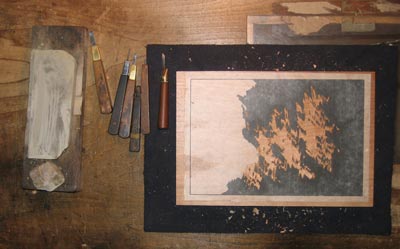Posted by Dave Bull at 2:11 PM, March 30, 2009
Continued from [River in Spring - 1]

I spent the past couple of days preparing the set of tracings to guide the carving. This print will have a 'key' block, in the sense that there is a block with a number of black outlines, but that block won't be carved first and then used to produce colour separations, as in the classical procedure.
Instead, I'm pulling colour separation sheets from the Photoshop rough-up. I think everything should match up once I'm done, but I'll certainly have to be careful when cutting the colour blocks, and keep to the 'plan'.
Speaking of colour blocks, here's the second one, nearly done ... (clickable)


The thread continues in [River in Spring - 3] ...
So Dave, is it a keyblock or not? I'm having some theoretical problems with the whole keyblock thing. I don't think I've ever made one since photoshop makes it un-necessary, but if one block is used to help map out another perhaps it becomes a keyblock. In this sense there could be a number of keyblocks in one print. In a reduction print every reduction would become a fresh keyblock. Or is a keyblock any block rendered in black or grey with some lines thrown in.

Well, 'key' - by definition - is the block to which others are keyed ... are lined up. In the classical tradition, this is the block with the (usually) black outlines - always carved first; always printed first.
But in this print, there will be a number of coloured areas not constrained by the lines, and that's why I've printed separations from Photoshop, as the key won't help me locate those areas. But there is also going to be a lot of colour that does fit within the lines, so I have to be careful to carve exactly what I have printed out, on all the sheets.

I understand the idea of the keyblock, particularly in the Japanese tradition, but I've always preferred to think of the keyblock more like a keystone - not the pattern for everything else, but the piece that holds everything together. Consequently, the keyblock needn't consist of the outlines of every color area, but might only contain a few little touches that 'finishes' the composition.




